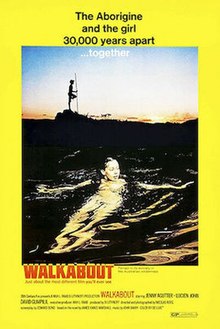A walkabout is an Australian aboriginal ritual of manhood.

Nicolas Jack Roeg was an English film director and cinematographer, best known for directing Performance (1970), Walkabout (1971), Don't Look Now (1973), The Man Who Fell to Earth (1976), Bad Timing (1980) and The Witches (1990).
The Sundowners is a 1960 Technicolor comedy-drama film that tells the story of a 1920s Australian outback family torn between the father's desires to continue his nomadic sheep-herding ways and the wife and son's desire to settle in one place. The Sundowners was produced and directed by Fred Zinnemann, adapted by Isobel Lennart from Jon Cleary's 1952 novel of the same name, with Deborah Kerr, Robert Mitchum, and Peter Ustinov, Glynis Johns, Mervyn Johns, Dina Merrill, Michael Anderson Jr., and Chips Rafferty.

Jennifer Ann Agutter is an English actress. She began her career as a child actress in 1964, appearing in East of Sudan, Star!, and two adaptations of The Railway Children; the BBC's 1968 television serial and the 1970 film version. In 1971 she also starred in the critically acclaimed film Walkabout and the TV film The Snow Goose, for which she won an Emmy Award for Outstanding Supporting Actress in a Drama.

Crocodile Dundee is a 1986 action comedy film set in the Australian Outback and in New York City. It stars Paul Hogan as the weathered Mick Dundee, and American actress Linda Kozlowski as reporter Sue Charlton. Inspired by the true-life exploits of Rod Ansell, the film was made on a budget of under $10 million as a deliberate attempt to make a commercial Australian film that would appeal to a mainstream American audience, but proved to be a worldwide phenomenon.

David Dhalatnghu Gulpilil was an Australian actor and dancer. He was known for his roles in the films Walkabout (1971), Storm Boy (1976), The Last Wave (1977), Crocodile Dundee (1986), Rabbit-Proof Fence, The Tracker and Australia (2008).

Don't Look Now is a 1973 English-language thriller film directed by Nicolas Roeg, adapted from the 1971 short story by Daphne du Maurier. Julie Christie and Donald Sutherland portray Laura and John Baxter, a married couple who travel to Venice following the recent accidental death of their daughter, after John accepts a commission to restore a church. They encounter two sisters, one of whom claims to be clairvoyant and informs them that their daughter is trying to contact them and warn them of danger. John at first dismisses their claims, but starts to experience mysterious sightings himself.

Insignificance is a 1985 British alternate history drama film directed by Nicolas Roeg, and starring Gary Busey, Michael Emil, Theresa Russell, Tony Curtis, and Will Sampson. Adapted by Terry Johnson from his 1982 play of the same name, the film follows four famous characters who converge in a New York City hotel one night in 1954: Joe DiMaggio, Albert Einstein, Marilyn Monroe, and Joseph McCarthy—billed as The Ballplayer, The Professor, The Actress and The Senator, respectively.

Theresa Lynn Russell is an American actress whose career spans over four decades. Her filmography includes over 50 feature films, ranging from mainstream to independent and experimental films.

Bad Timing is a 1980 British psychological drama film directed by Nicolas Roeg and starring Art Garfunkel, Theresa Russell, Harvey Keitel and Denholm Elliott. The plot focuses on an American woman and a psychology professor living in Vienna, and, largely told through nonlinear flashbacks, examines the details of their turbulent relationship as uncovered by a detective investigating her apparent suicide attempt.

The Witches is a 1990 American dark fantasy comedy horror film directed by Nicolas Roeg from a screenplay by Allan Scott, based on the 1983 novel of the same name by Roald Dahl. The film stars Anjelica Huston and Mai Zetterling. The plot features evil witches who masquerade as ordinary women and follows a boy and his grandmother, who must find a way to foil their plans of turning children into mice.

Fat Girl is a 2001 coming-of-age drama film written and directed by Catherine Breillat, and starring Anaïs Reboux and Roxane Mesquida. It was released in certain English-speaking countries under the alternative titles For My Sister and Story of a Whale. The film's plot follows two young sisters as they deal with coming-of-age, sibling rivalry, and desire while on vacation with their family.
Donald Gordon Payne was an English author, most famous for his 1959 novel, Walkabout. Payne was made a Fellow of the Royal Geographical Society in 1962.
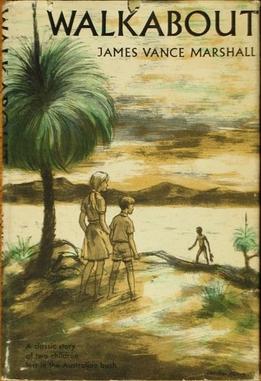
Walkabout is a novel written by James Vance Marshall, first published in 1959 as The Children. It is about two children, a teenage sister and her younger brother, who get lost in the Australian Outback and are helped by an Indigenous Australian teenage boy on his walkabout. A film based on the book, with the same title came out in 1971, but deviated from the original plot.
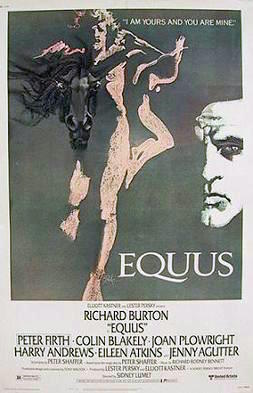
Equus is a 1977 psychological drama film directed by Sidney Lumet and written by Peter Shaffer, based on his play of the same name. The film stars Richard Burton, Peter Firth, Colin Blakely, Joan Plowright, Eileen Atkins, and Jenny Agutter. The story concerns a psychiatrist treating a teenager who has blinded horses in a stable, attempting to find the root of his horse worship.

The Railway Children is a 1970 British family drama film based on the 1906 novel of the same name by E. Nesbit. The film was directed by Lionel Jeffries and stars Dinah Sheridan, Jenny Agutter, Sally Thomsett, Gary Warren and Bernard Cribbins in leading roles. The film was released to cinemas in the United Kingdom on 21 December 1970.
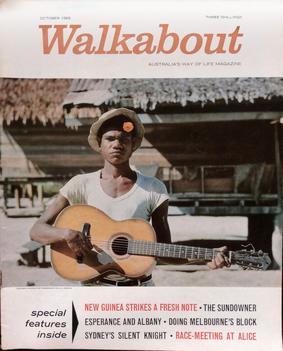
Walkabout was an Australian illustrated magazine published from 1934 to 1974 combining cultural, geographic, and scientific content with travel literature. Initially a travel magazine, in its forty-year run it featured a popular mix of articles by travellers, officials, residents, journalists, naturalists, anthropologists and novelists, illustrated by Australian photojournalists. Its title derived "from the supposed 'racial characteristic of the Australian Aboriginal who is always on the move'."
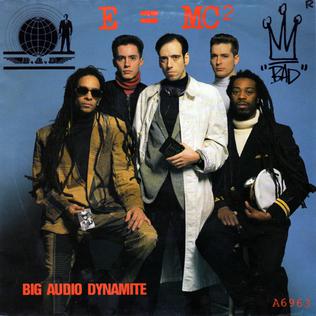
"E=MC2" is a 1986 single by the English band Big Audio Dynamite, released as the second single from their debut studio album, This Is Big Audio Dynamite (1985). The song was the band's first Top 40 hit on the UK Singles Chart, peaking at number 11. Additionally, it peaked at number 37 on the Billboard Hot Dance Club Play chart in the United States. The song features prominent dialogue samples from the crime drama film Performance (1970). The song is also played during the opening titles of the French movie Forces spéciales (2011).

We of the Never Never is a 1982 Australian drama film directed by Igor Auzins and starring Angela Punch McGregor, Arthur Dignam, John Jarratt, and Tony Barry. It is based on the 1908 autobiographical novel We of the Never Never by Jeannie Gunn. It was nominated for five AFI awards and earned one award for best cinematography.
Luc Roeg is a British cinematographer and film producer, founder of the Independent Entertainment production company.
